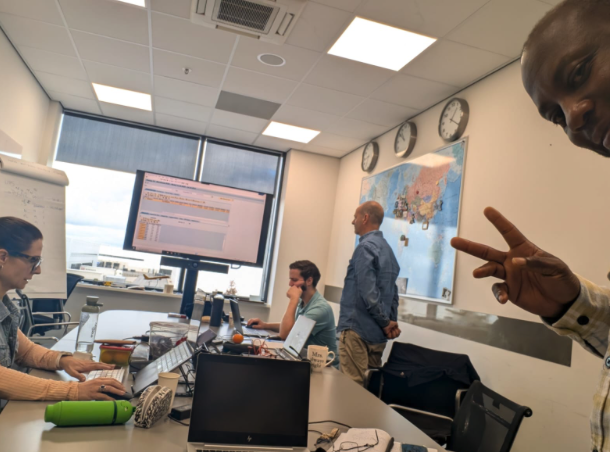In an era of supply chain volatility, consumer expectations, and digitization, warehouse operations are no longer a back-office cost center — they’re a competitive battleground. At BandeSoft, we’re seeing clients increasingly turn to SAP Extended Warehouse Management (EWM) not just as a logistics tool, but as a core enabler of business agility.
Having recently deployed a team on the ground in Amsterdam working alongside a client’s project, we’re witnessing first-hand how EWM transformations go beyond code and configurations — they shift how companies think about goods, movement, and metrics.
The Evolution of Warehouse Management
Warehouse systems used to focus on basic functions: receiving, putaway, picking, shipping. But modern operations demand more:
- Real-time responsiveness to demand surges, supply fluctuations, and last-minute changes
- Transparency and traceability across zones, tasks, material flows
- Intelligent automation and optimization — dynamic slotting, predictive replenishment, resource leveling
- Seamless integration with ERP, transportation, yard, and fulfillment systems
SAP EWM, especially when integrated with SAP S/4HANA, provides the technological backbone to support these demands. But the real value lies in the business transformation — aligning people, process, and systems.
Key Capabilities Driving Value
Below are the standout EWM features we’ve seen making real impact in client settings:
| Capability | Business Value |
| Decentralized EWM / Embedded EWM | Flexibility to host warehouse logic within the S/4 system or decoupled setups |
| Labor and Resource Management | Better assignment of operators, tasks, and equipment utilization |
| Slotting & Rearrangement Tools | Automatically suggest optimal storage areas to reduce pick/travel time |
| Material Flow System (MFS) Integration | Control of conveyors, automation, AGVs directly from EWM |
| Event Handling & Exception Processing | Rule-based workflows for deviations, escalations, and alerts |
| Fiori-based UX & Role Apps | Easier work for warehouse staff using intuitive, role-specific screens |
| Cross-Docking & Yard Integration | Minimize touches, enable seamless inbound-to-outbound flows |
| Embedded Analytics & KPIs | Real-time dashboards to track throughput, aging, service metrics |
These are not just features on a checklist — in practice, they become levers to reduce costs, shorten cycle time, and elevate operational reliability.
Trends Shaping EWM Adoption
In our conversations across industries, several macro trends are pushing EWM initiatives:
- Omnichannel & micro-fulfillment pressure
Rapid order fulfillment from local DCs and micro-hubs demands agile warehouse logic. - Supply chain volatility & resilience
Business continuity requires systems that can adapt to disruptions, reroute flows, and absorb variability. - Labor scarcity & rising wage costs
Automating repeatable tasks and optimizing labor usage becomes essential. - Digital twin & predictive insights
Simulating “what-if” scenarios helps companies plan capacity, staffing, or buffer strategies. - End-to-end integration
Warehouse logic can no longer live in isolation — transportation, yard, customs, and order orchestration need to talk. - Cloud, sustainability & modular deployments
Clients want lighter, scalable, green, and modular implementations (e.g. choosing subsets of EWM first).
These dynamics mean that EWM projects are not one-off system installs — they’re strategic investments.
A Practical Roadmap to EWM Transformation
From our Amsterdam project and others, we’ve found that the most successful implementations follow a structured but flexible approach:
- Process & baseline assessment
Map current warehouse flows, identify pain points, and benchmark KPIs. - Define future-state scenarios
Lay out “to-be” process models, automation potential, system boundaries. - Pilot & phased rollout
Start with a limited zone (e.g. inbound, putaway) before expanding across the warehouse network. - Change management & training
Engage warehouse staff early, provide role-based training and dry runs. - Iterate & optimize
Use real data post-go live to refine slotting rules, exception logic, and automation scripts. - Scale & integrate
Gradually extend EWM into adjacent domains — yard logistics, transportation handoff, customs, IoT sensors.
When done right, warehouse teams evolve from firefighting to value-driving performers.
The BandeSoft Difference
Our hands-on presence in Amsterdam underscores how BandeSoft approaches such transformations:
- We embed our teams on site, working side by side with client operations and IT staff
- We bring cross-discipline expertise (warehouse, logistics, automation, SAP integration)
- We drive alignment between process design and technical configuration — bridging theory and execution
- We monitor adoption post-go live and provide iterative enhancements

We believe that the image you see (our colleague working with the client team in Amsterdam) is emblematic of our philosophy: co-creation, on the ground, focused on tangible outcomes.
Final Thoughts
Warehouse modernization is no longer optional — it’s imperative for any company that wants to compete on speed, cost, and customer experience. SAP EWM is not just a tool, but a platform — one that can anchor a broader logistics transformation.
If your team is planning a new EWM implementation or contemplating upgrading an existing warehouse system, start with the big picture: How can warehousing become an enabler — not just an enforcer — of your business goals?
At BandeSoft, we’d welcome the chance to partner with you in that journey.
